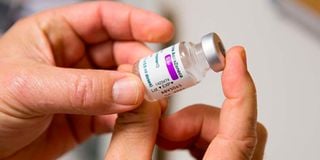AstraZeneca vaccine: How does it work and what are the side effects

AstraZeneca vaccine
Health professionals at high risk of contracting Covid-19 will be prioritised in the roll-out of the AstraZeneca/Oxford vaccines.
The World Health Organisation (WHO) has urged countries to ensure that most of their health workers, if not all, have received their vaccine shots in the first 100 days of the year.
According to the national Covid-19 vaccines deployment and vaccination plan, early vaccination will focus on administration sites that can reach prioritised populations. These include levels four, five, and six hospitals, estimated at five per cent of the total facilities (about 479; 284 public and 195 private health centres).
The government will spend about Sh933.2 million in Phase I of the vaccination programme. A huge chunk of the money (Sh592.6 million) will be used to store, distribute, clear, procure vaccines and injecting devices enough to cover 280,000 of the targeted population.
The government also intends to pump in Sh70.8 million towards training and Sh17.2 million on planning and coordination. Sh232million will go towards advocacy, communication, and community mobilisation initiatives, while Sh20.6 million will be spent on data management, monitoring, and surveillance.
In Phase I, the Ministry of Health intends to finance the total budget from its resources.

Serum Institute India, the world's biggest vaccine maker, which manufactures the AstraZeneca vaccine.
How does the vaccine work?
Commonly referred to as AstraZeneca or AZD1222, it is manufactured by the Serum Institute of India (SII).
AZD122 is made from a weakened (attenuated) version of a common cold virus (known as an adenovirus) from chimpanzees. It has been modified to look more like coronavirus, although it cannot cause illness.
Once injected, the vaccine teaches the body’s immune system how to fight the virus, should it need to. Research has shown it is highly effective. No one given the vaccine in trials developed severe Covid or needed hospital treatment.
It was proven at Phase III, the final stage of clinical trials, to be 63.1 per cent effective against Covid-19 irrespective of interdose interval from trial participants in the United Kingdom, Brazil, and South Africa, who received two standard doses. The effectiveness of the vaccine, however, tended to be higher when the interval between doses was longer.
Unlike Pfizer’s jab – which has to be kept at an extremely cold temperature (-70C) – AZD1222 can be stored in a normal fridge with temperatures of between two and eight degrees, making it much easier to distribute.
Although some people get mild side effects, the vaccines in use have been found to be safe, and the country's drug regulator, the Pharmacy and Poisons Board (PPB) issued authorisation for its use.
Dosage
The vaccine is recommended in two doses (0.5ml) given intramuscularly. The WHO recommends an interval of eight to 12 weeks between the doses.
“If the second dose is inadvertently administered less than four weeks after the first, the dose does not need to be repeated,” according to interim recommendations for use of the AstraZeneca vaccine.
A recent study found a single dose offered 76 per cent protection for three months, and this went up to 82 per cent after the second.
Side effects
Technically, medical experts say vaccines do not cause illness. Instead, they teach the body’s immune system to recognise and fight the infection they have been designed to protect against. In this case, the jabs use a harmless version or part of coronavirus to teach the body how to recognise and fight the virus, should it need to.
Some people do suffer mild symptoms after being vaccinated from the body’s response to the vaccine.
Common reactions that may affect more than one in 10 people, and typically get better within days, include sore arm, headache, chills, tiredness, feeling sick, fever, dizziness, and weakness.
Some side effects from the body’s response to the vaccines are to be expected. Medical experts have warned that recipients of the vaccine should expect some form of after-injection pain and, in some occasions, mild side effects.
“We don’t foresee any serious side effects but anticipate some form of malaise, soreness, and a bit of fever but just for a few days,” said Dr Ombeva Malande, a vaccinologist.
Malaise is described as either a feeling of overall weakness, discomfort, or a feeling like you have an illness. The World Health Organisation says the potential benefits of AZD1222 outweigh the known and potential risks.
About one in three people recently given a Covid vaccine in the UK reported some side effects. A common one was some soreness around the injection site, but none was serious, the UK researchers who gathered the feedback found.
Experts say the findings, from about 40,000 people – mostly healthcare workers – are reassuring for the millions having the vaccines. The researchers asked for feedback, via an app, from people who had received at least one dose of the Pfizer-BioNTech vaccine by early January.
The Zoe app team from King’s College London found that 37 per cent experienced some local “after-effects”, such as pain or swelling near the site of the injection, after their first dose, rising to about 45 per cent of the 10,000 who had received two doses.
Fourteen per cent had at least one whole-body (systemic) after-effect – such as fever, aches, or chills – within seven days of the first dose, rising to about 22 per cent after the second dose. These after-effects get better within a few days.
Protection period
It is not yet known how long protection lasts with any of the coronavirus vaccines. A study found unvaccinated people are protected after catching Covid-19 for at least six months. Vaccines are likely to provide stronger protection than this.





